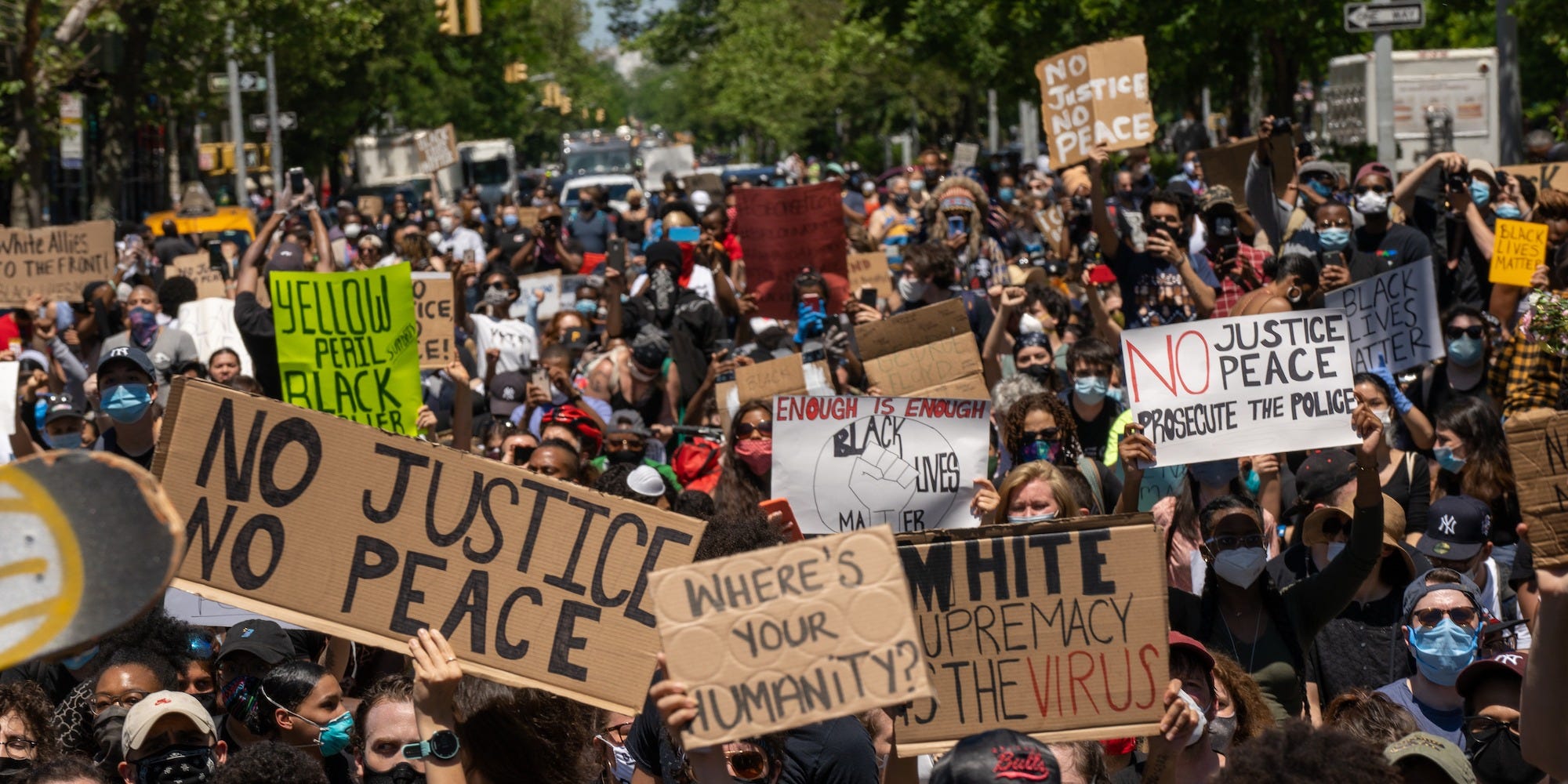- The United States has seen nationwide protests for weeks over the death of George Floyd in police custody, and the frustration that racism and racial inequality still persist throughout modern American life.
- Data and research have extensively documented the ways in which Black Americans are underrepresented, overrepresented, or experience different treatment from their white counterparts.
- These 26 charts show the extent of racial disparities in America, in areas like employment, wealth, education, home ownership, healthcare, and incarceration.
- Visit Business Insider’s homepage for more stories.
Nationwide protests in recent weeks have rekindled a roaring public discourse about racial inequality in America.
George Floyd’s death in police custody on May 25 let loose a groundswell of public rage about the way Black Americans are policed. But it also sparked a deeper conversation about the way they experience all aspects of modern life, whether it’s underrepresentation in college attainment rates, or over-representation in COVID-19 hospitalizations.
Extensive academic research and data collected by the federal government and researchers has documented numerous ways that Black Americans experience life in the United States differently from their white counterparts.
It’s called “systemic” racism because it’s ingrained in nearly every way people move through society in the policies and practices at institutions like banks, schools, companies, government agencies, and law enforcement.
The resulting data show that these disparities exist along nearly every facet of American life, including employment, wealth, education, home ownership, healthcare, and incarceration.
Here are 26 charts that show the stark differences between the Black and white experience, because of systemic racism.
The employment-population ratio measures the share of a demographic group that has a job, and it's been lower for Black people for years.

The employment-population ratio for Black Americans has historically tended to fall quite a bit lower than for whites or Latinos.
Since the coronavirus pandemic and subsequent lockdowns across the country triggered a recession starting in March, employment for all racial groups has fallen dramatically, and fewer than half of all Black Americans had a job in April and May.
The unemployment rate has also spiked for all racial groups in the US during the coronavirus pandemic, and is especially high for Black Americans.

Just as Black employment has historically been lower than for whites, the unemployment rate among Black Americans been higher. While unemployment was slightly lower for white and Latino Americans in May after a surprisingly good jobs report, the rate continued to tick up for Black workers.
Black Americans are underrepresented in high-paying jobs
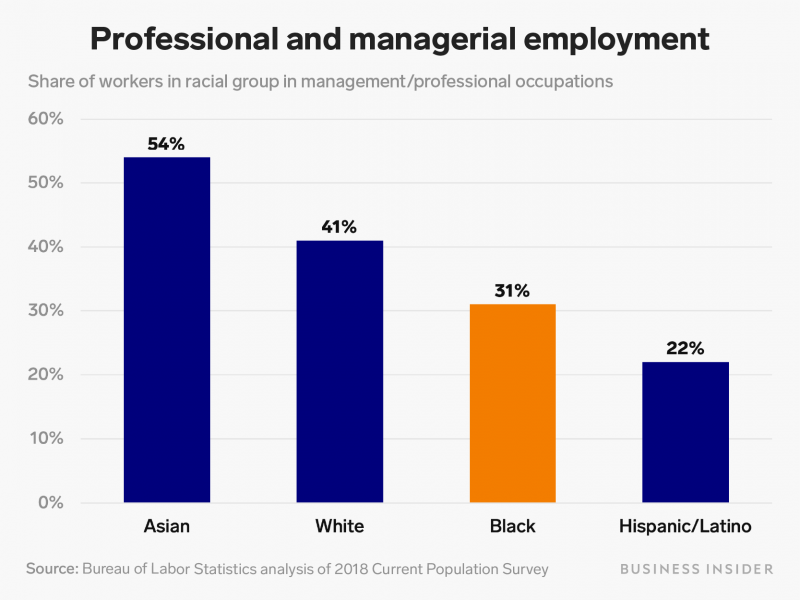
The Bureau of Labor Statistics shows that 54% of employed Asians worked in management, professional, and related occupations - the highest-paying major occupational category - compared with 41% of employed whites, 31% employed Blacks, and 22% of employed Hispanics.
This, in part, can be explained by racist hiring practices that kept Blacks out of business for decades under Jim Crow. It can also be explained by more subtle forms of prejudice today.
One Harvard University study found that when Blacks and Asians "whitened" their resumes - for example, used "American" or "white"-sounding names - they got more callbacks for corporate interviews. Twenty-five percent of Black candidates received callbacks from their whitened resumes, while only 10% got calls when they left ethnic details on their resume.
In addition, many companies rely on employee social networks for referrals, which can be problematic if your company is largely white, diversity experts told Business Insider. One survey found that three quarters of white employees don't have any non-white friends.
People of color, and especially Black Americans, are severely underrepresented at the top of the corporate hierarchy.
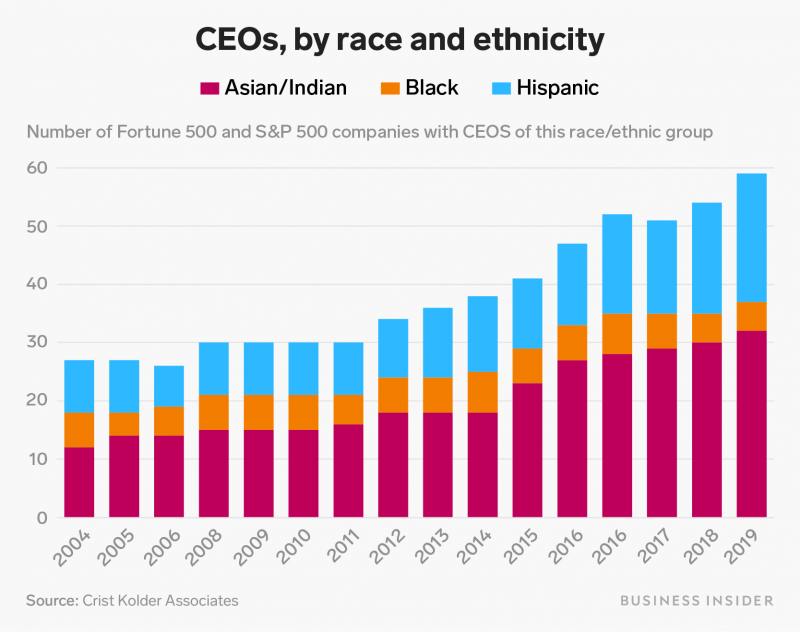
A 2019 study by executive-staffing firm Crist Kolder associates looked at the CEOs of Fortune 500 and S&P 500 companies. Only 8.7% of the 675 companies in the study had CEOs of color.
As of 2020, only four Fortune 500 companies have Black CEOs: pharmaceutical company Merck & Co., home improvement retailer Lowe's, fashion holding company Tapestry, and insurance company TIAA.
Black Americans have historically been underrepresented in the highest echelons of government, as well.
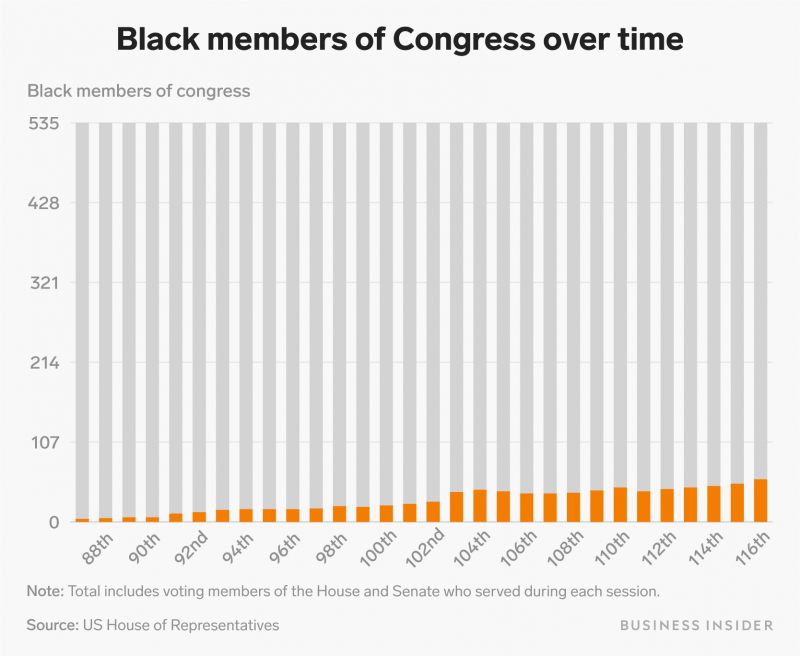
While the 116th Congress, which came into session after the 2018 midterm elections, was the most diverse ever, only 57 of the current 535 voting members of Congress are Black.
Black workers have historically earned far less than white workers.
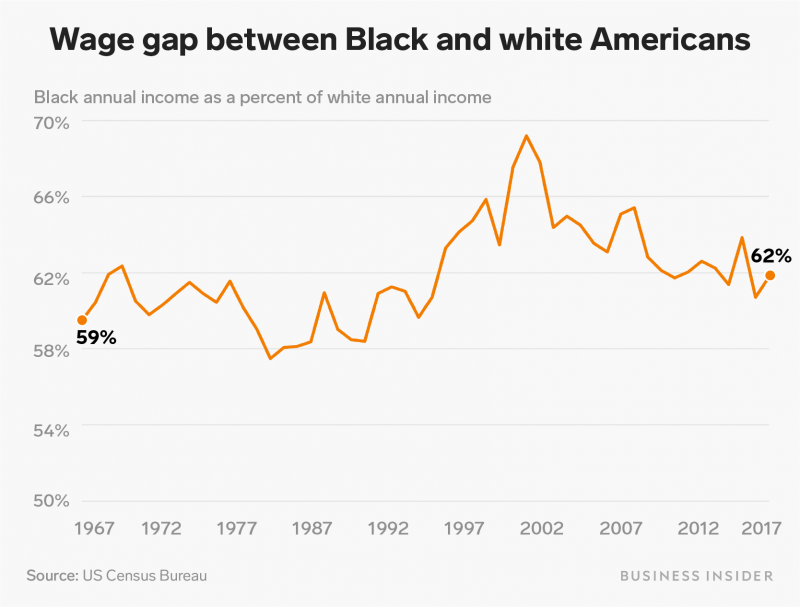
In 2018, the average Black worker earned just 62% of what the average white worker made.
Similarly, overall income for Black Americans was about 42% lower than for whites in 2018.
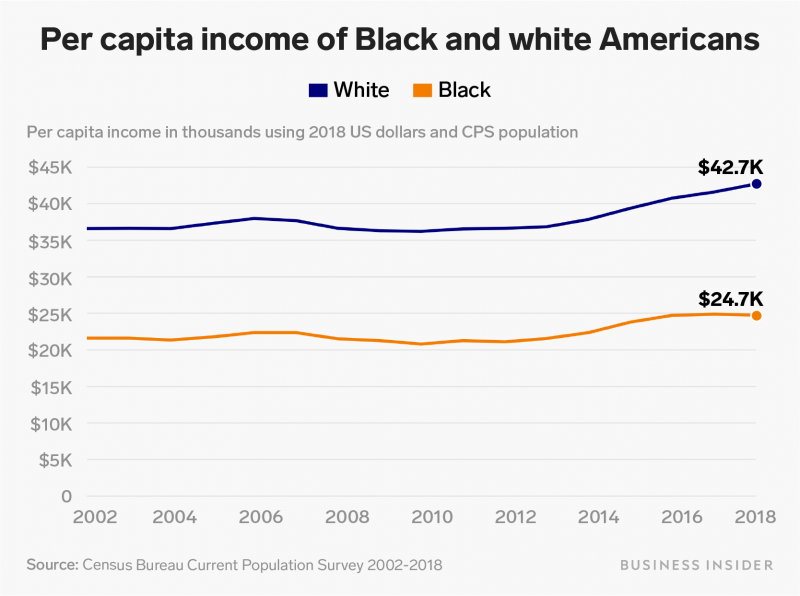
There's a similar disparity at the household level. Lower incomes mean that the poverty rate for Black families is over twice that of white families.
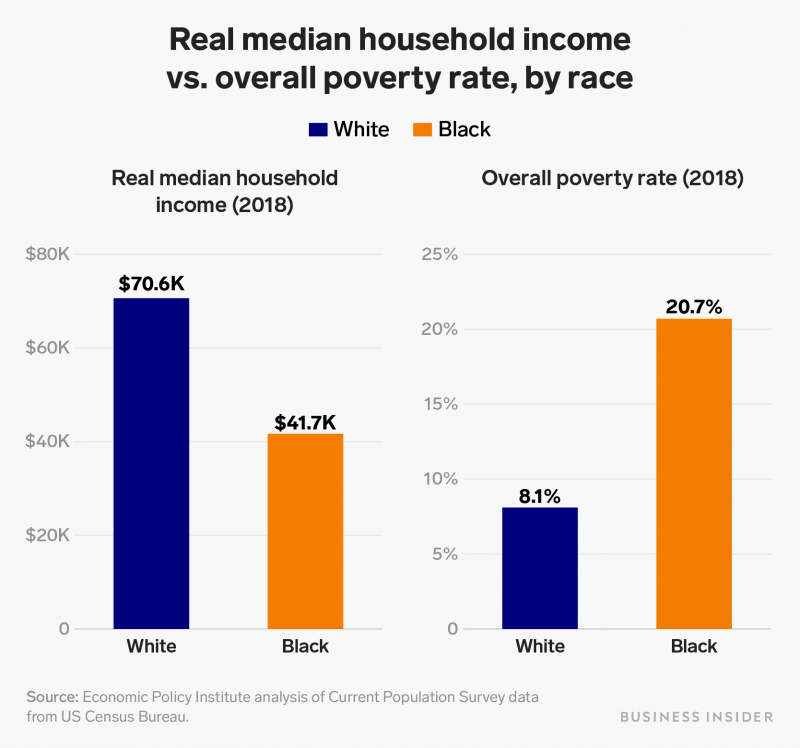
The aggregate wealth white households have held has historically far outstripped that held by the Black community. And while it has increased for white people since the 1980s, it's remained stagnant for Black people.
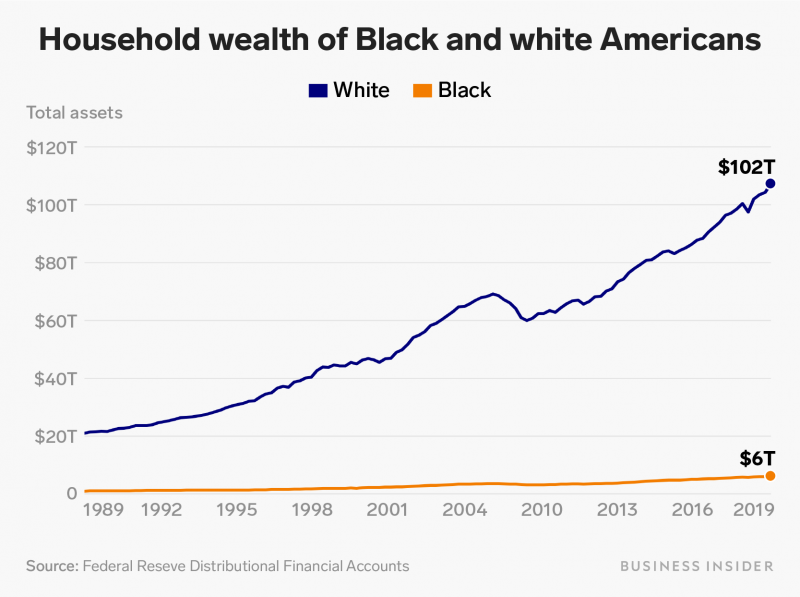
This chart shows the aggregate amount of wealth across groups. While there are about six times as many white Americans as Black Americans, the aggregate wealth held by the former is about 17 times that held by the latter.
One of the contributing factors to the household wealth disparity is student loans.
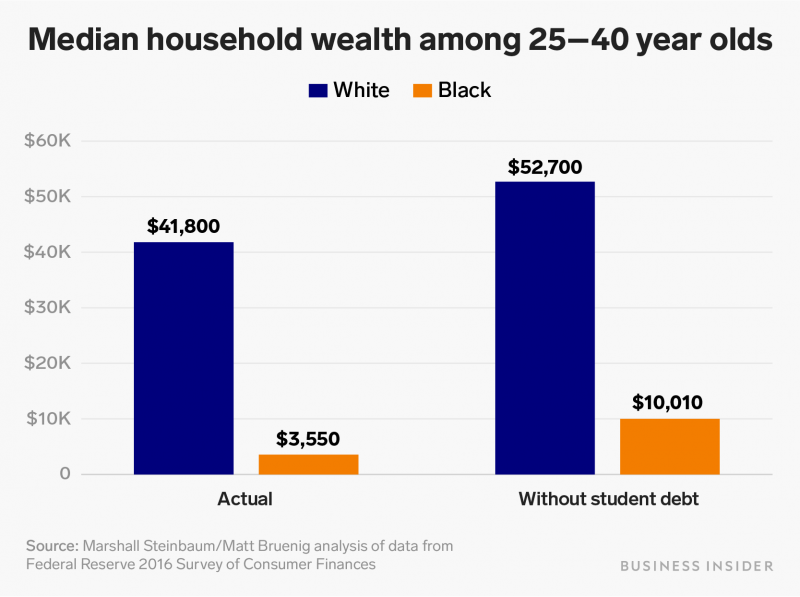
A 2018 analysis by the left-leaning think tank The Roosevelt Institute suggested that without student loan debt, the wealth gap between young white and Black households would be vastly lower.
The wage gap between races also interacts with the gender wage gap between men and women.
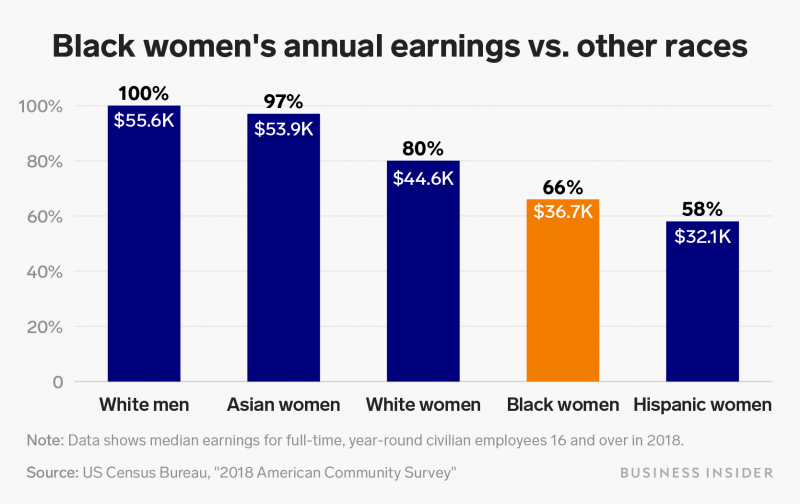
In 2018, the typical Black woman earned just 66% what the typical white man made.
One common way to illustrate the gender and race wage gaps is through looking at "equal pay days" for different groups.

Equal pay day for a particular racial or gender group marks the extra days someone in that group has to work into the next year to earn what the typical white man earned in the previous year.
Based on income figures from 2018, it would take the median black woman worker 226 extra days into a new year to earn what a median white male worker made in the previous year.
A key part of the "American Dream" is leaving your children in a better economic position than you were in, but that dream is less attainable for Black Americans.
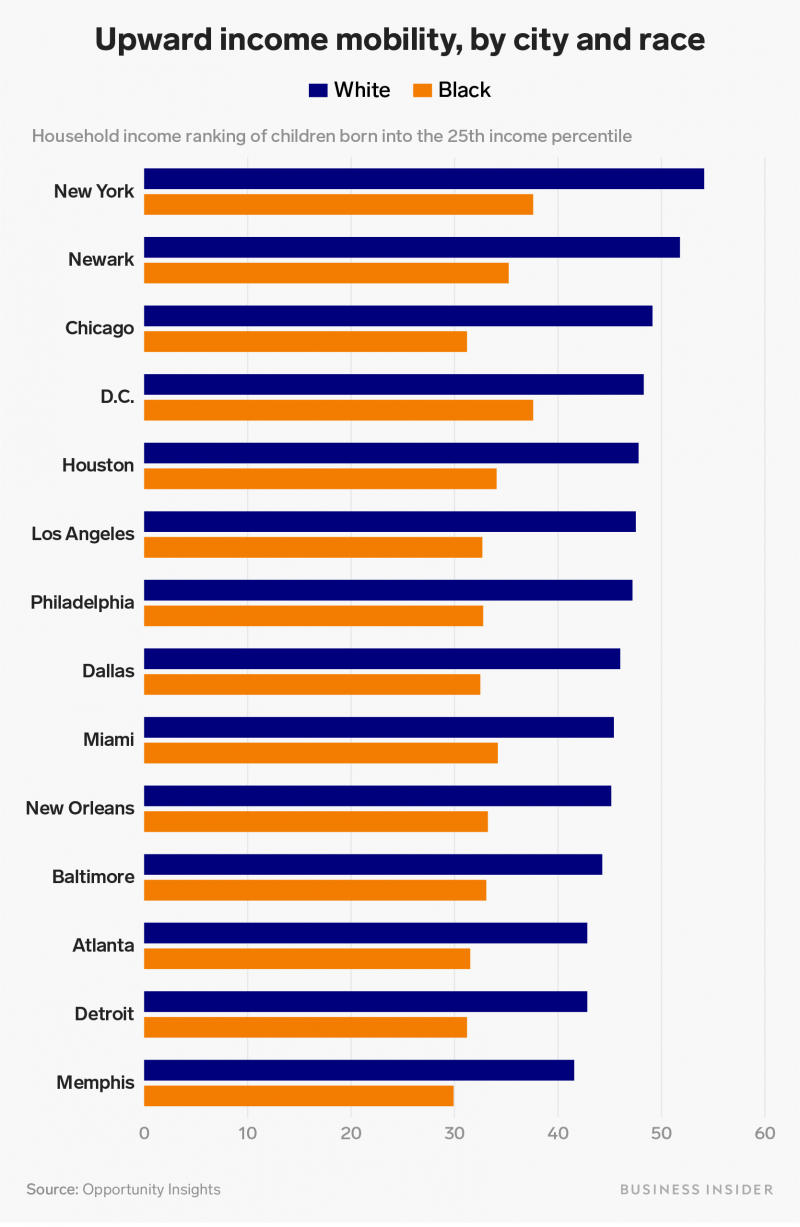
An analysis by Opportunity Insights, a research organization studying intergenerational economic and social mobility, found that the children of white households in the bottom quarter of the income distribution were much more likely than children from Black households at the bottom to move up into a higher income bracket over their lives.
Educational opportunities remain starkly split by race.
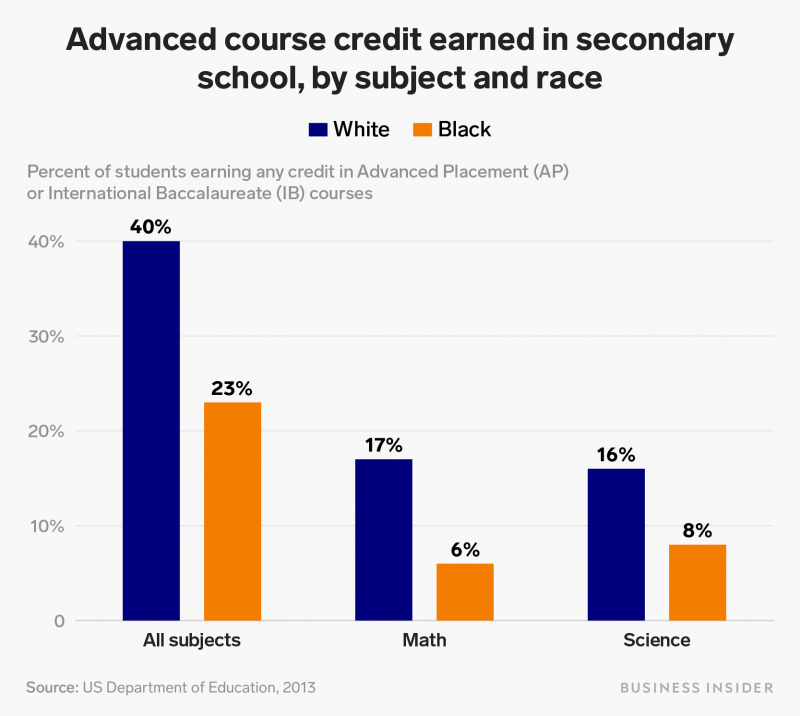
A study by the Department of Education showed that in 2013, Black high school students were only a bit more than half as likely as white students to have any Advanced Placement or International Baccalaureate credit, and only about a third as likely to have AP/IB credit for math.
The share of both white and Black Americans with college degrees has increased dramatically over the last half-century, but there's still a gap.
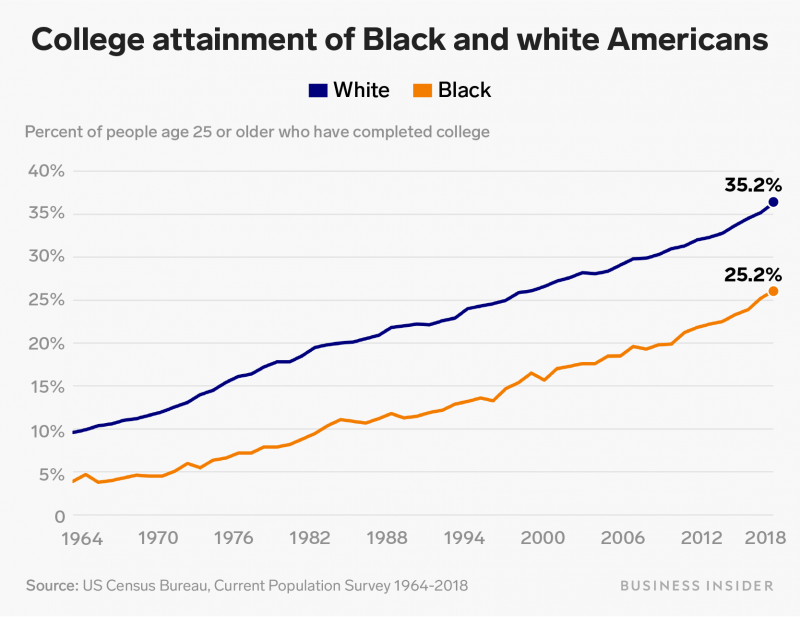
The pipeline is part of the problem - if fewer Black children go to schools with robust resources or even math and science classes in high school, then there will be fewer students who have the support and credentials to go to college.
Even though the government desegregated schools 66 years ago, about half of students in the US still attend either predominantly white or non-white schools, according to a 2019 report from nonprofit group EdBuild. And the differences between those schools are still visible.
"For every student enrolled, the average nonwhite school district receives $2,226 less than a white school district," the report authors wrote.
And that disparity is also true when comparing poor districts. The authors wrote:
"Poor-white school districts receive about $150 less per student than the national average - an injustice all to itself. Yet they are still receiving nearly $1,500 more than poor-nonwhite school districts."
As with income, intergenerational educational mobility varies widely between racial groups.

This chart, based on another study from Opportunity Insights, looks at the likelihood that a child whose parents had only a high school diploma goes on to earn a college degree or higher.
Only 15% of Black students from less-educated households went on to finish college, well below the 25% of white children who earned a degree.
When they tried to get financing from banks, Black mortgage applicants were more likely to be denied loans than aspiring homeowners of other races.

While formal discrimination for home loans has been illegal in the US for decades, the ongoing divide in mortgage approval rates shows that more informal practices could still be in effect.
Thus, the share of Black households that own their own homes is lower than other racial groups.
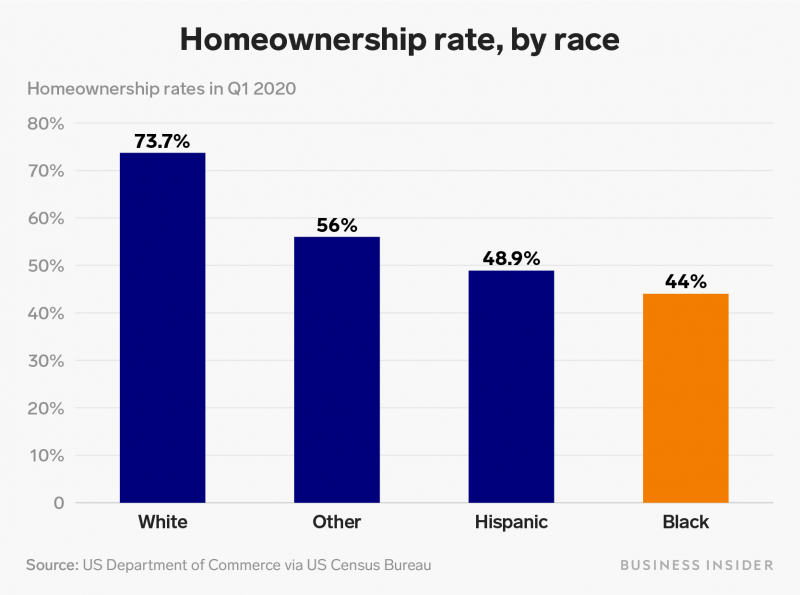
Lower incomes and higher rates of poverty, combined with difficulties in getting mortgage approval, mean that homeownership rates for Black Americans remain low.
The coronavirus crisis has only exacerbated an already wide disparity in access to healthcare.
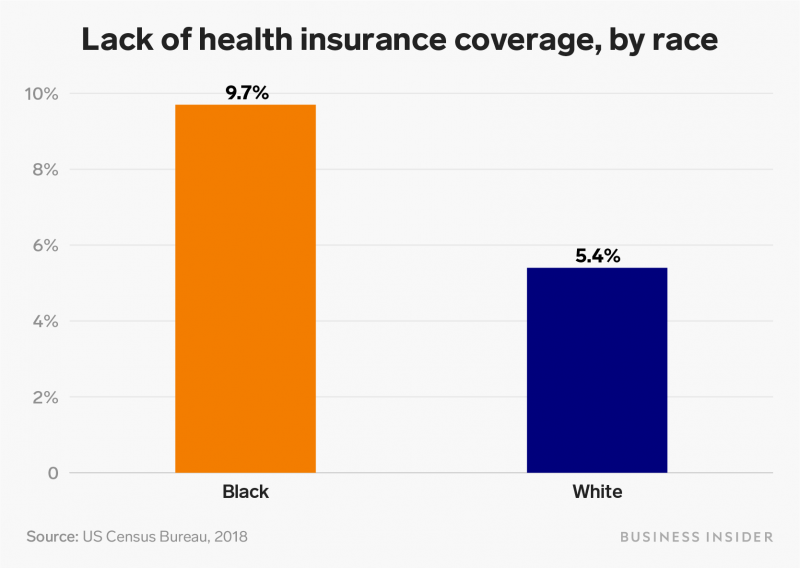
Black Americans were nearly twice as likely as their white neighbors to lack health insurance as recently as 2018.
The current coronavirus pandemic has had a disparate impact on people of color.
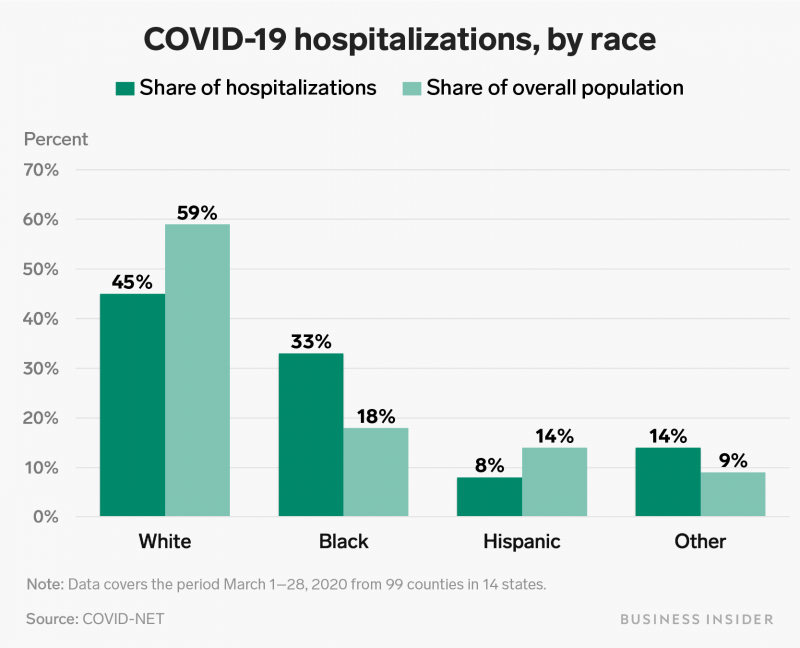
An early CDC analysis of COVID-19 hospitalizations across 99 counties in 14 states showed that a third of hospitalizations in the areas studied from the new disease were among Black Americans, disproportionately higher than their population share of 18% in those counties.
As Tedros Adhanom Ghebreyesus, director-general of the World Health Organization, said in May, "Crisis can exacerbate existing inequalities."
Black Americans have higher rates of underlying health conditions like diabetes and hypertension that could put them at a higher risk for developing complications from the novel coronavirus.
They also disproportionately hold jobs deemed essential during the pandemic. While Black Americans make up 12% of the overall workforce, they account for 17% of frontline employees, according to a study from the Center for Economic and Policy Research.
Black prisoners are overrepresented in the US prison population compared to their share of the total US population.

According to the Bureau of Justice Statistics, Black Americans are overrepresented in the country's incarcerated population. In 2018, Black inmates made up roughly 33% of the country's prison population - yet just 12% of the US's total population. White inmates, meanwhile, made up 30% of the prison population and 60% of the country's total population.
FBI arrest data show that Black Americans also make up the majority of suspects arrested and charged with violent crimes such as murder and robbery, which generally carry lengthy sentences. But criminal-justice reform advocates have argued that even taking crime rates into account, Blacks Americans still experience unequal treatment in the justice system compared to their white counterparts.
For instance, Black Americans are much more likely to get arrested on drug charges than white Americans, even though usage rates are comparable. Once arrested, Black defendants are more likely than white defendants to be denied bail, and more likely to receive harsher charges and sentences than white defendants who committed the same offenses, according to The Sentencing Project.
Black men are roughly five times more likely to be imprisoned than their white counterparts — and nearly 13 times as likely in the 18-19 age group.

The most recent numbers available on imprisonment rates come from the Bureau of Justice Statistics' analysis of 2018 data, which showed that Black men aged 18-19 were 12.7 times as likely to be imprisoned as their white peers, and Black men of all ages were roughly 5.8 times more likely to be imprisoned than white men.
A Pew Research Center analysis of the data showed that the Black imprisonment rate has actually dropped by 34% since 2006 - the greatest decline across all races.
Yet even still, Black Americans - and particularly Black men - remain more likely than any other group to be imprisoned. For every 100,000 Black men there are 2,272 inmates, whereas for every 100,000 white men there are just 392 inmates.
Marijuana usage rates are similar between white and Black Americans, yet BlackAmericans are 3.64 times more likely to get arrested on marijuana possession charges.
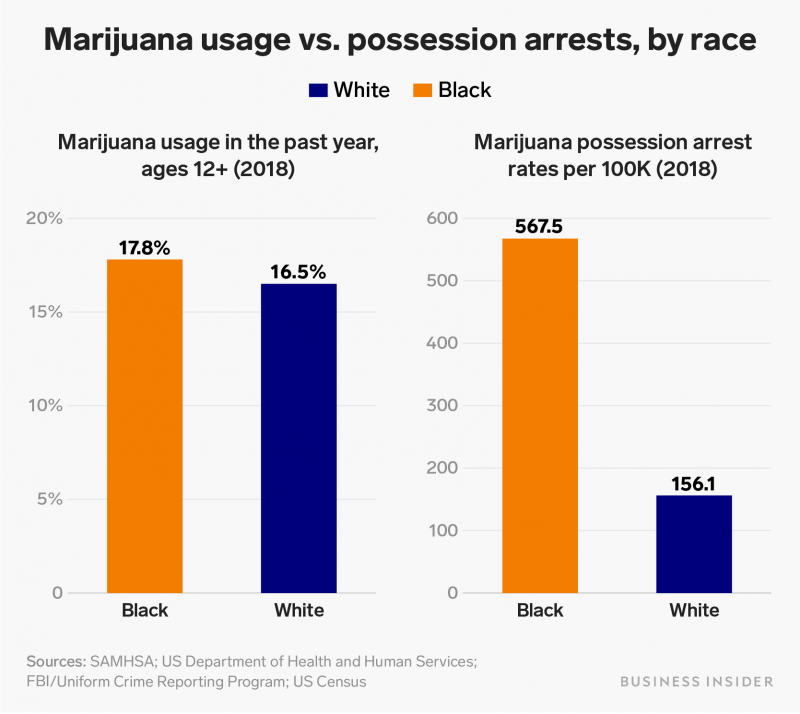
According to the federal government's Substance Abuse and Mental Health Services Administration, marijuana usage between Black and white Americans is similar. Just 18% of Black people over the age of 12 in 2018 reported using marijuana within the past year, while 17% of white people over the age of 12 reported the same.
But the usage rate is where the similarities end - that same year, Black Americans were arrested 3.6 times more often than white Americans for marijuana possession, according to an American Civil Liberties Union analysis of FBI and US Census data.
The racial disparity in marijuana arrests has actually gotten worse in recent years, even though more states are legalizing or decriminalizing marijuana.

According to the ACLU's analysis of marijuana arrest data from the FBI's Uniform Crime Reporting Program, racial disparities in marijuana arrests have continued in every state.
Despite widespread reforms to state marijuana policies, the racial disparity has even gotten worse over the years, not better. For instance, in 2010, Black people were 3.31 times more likely to be arrested for marijuana possession than white people, and over the years the rate ticked up to 3.64 in 2018.
The marijuana arrests that continue to the present day have disproportionately "caused profound and far-reaching harm on the people arrested, convicted, and/or incarcerated for marijuana offenses," the ACLU wrote. "It has been a colossal waste of money and law enforcement resources that has only deepened the divide between communities and their governments and increased public hurt rather than safety."
Black people are overwhelmingly more likely than white people to be under parole supervision — and they're more likely to be sent back to prison for minor infractions.

Research from Columbia University's Justice Lab has shown that Black people are far more likely than white people to be under parole supervision. Though the federal prison system has largely abolished parole, most states still retain the practice of releasing some inmates from prison sentences early in exchange for heavy supervision while they try to get back on their feet.
New York state has a particularly extreme racial disparity when it comes to parole supervision. Black people are 6.77 times more likely to be under parole supervision than white people, the Justice Lab found. They are also 4.99 times more likely than white people to be re-incarcerated due to "technical" parole violations, meaning that they had parole revoked due to minor infractions such as missing an appointment, rather than committing a new crime.
A Justice Lab report said parole supervision has also had an unequal effect on Black people - even though some of the supervision requirements may seem neutral or sensible, they may be far harder for people in Black communities to abide by through no fault of their own.
For instance, one common parole requirement is for parolees to stay away from people who have felony convictions. Yet an estimated one-third of Black men have felony convictions. That means parolees could be ordered to stay away from friends, family members, and neighbors.
"People on parole … may be forced to choose between obeying the rules on one hand, or, on the other, risking a parole violation by spending time with relatives and friends who could be valuable sources of support, stability, housing, or employment connections," the Justice Lab report said.
Roughly half of those fatally shot by police are white, but Black Americans are fatally shot at a disproportionate rate compared to their representation in the US population.

The Washington Post has compiled one of the most thorough datasets available when it comes to fatal police shootings, and it has sparked debate over what it means when it comes to racial bias in police killings.
The data show that more than half of the people fatally shot by police in America within the last five years were actually white - but fatal police shootings of Black people were disproportionately high, considering they account for roughly 13% of the US population.
As of June 12, 2,469 white people had been fatally shot since 2015 at rate of 13 per million, whereas 1,293 Black people were fatally shot at a rate of 31 per million.
The database also comes with a number of other qualifiers - namely, that it tracks only fatal police shootings, not fatal police encounters in general. So the deaths of Black men like George Floyd, which occurred after a Minneapolis police officer knelt on his neck for nearly nine minutes, have not been included in the dataset, nor have the deaths of Eric Garner in Staten Island, who died from a police chokehold, or Freddie Gray in Baltimore, who died of spinal injuries he suffered in a police van.
It's also worth pointing out that every fatal police shooting included in the database has its own unique set of circumstances that may or may not have justified a shooting. For instance, the database includes Omar Mateen, the mass shooter who killed 49 people in an Orlando nightclub in 2016 before police fatally shot him.
The majority of fatal police shootings - 4,037 out of the 5,403 people fatally shot by police in the last five years - occurred when a suspect had either a gun or a knife.
Though the presence of a weapon does not in and of itself mean each of those police shootings was justified (for example, the database includes the fatal police shooting of Philando Castile, who was legally armed and obeyed the officer's commands during a traffic stop), officers are generally permitted to use deadly force when they believe a person poses a serious threat of injury or death.
But even when narrowing the data down to fatal police shootings of unarmed people, it shows a similar story as the aggregate data. Of the 352 instances where police fatally shot unarmed people, 145 of those people were white and 123 were Black (63 were Hispanic and 21 were designated "other" or "unknown.") - that's a rate of 10.7 white deaths per 10 million, and 30.1 Black deaths per 10 million.
